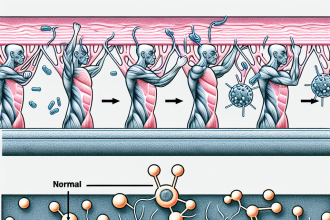-
Table of Contents
«Maintain healthy blood pressure with Raloxifen-HCl – your ally against hypertension.»
Introduction
Raloxifene-HCl es un medicamento recetado para tratar la osteoporosis en mujeres posmenopáusicas y reducir el riesgo de cáncer de mama en mujeres con alto riesgo. Sin embargo, es importante tener en cuenta que este medicamento puede afectar la presión arterial y es necesario estar atentos a cualquier cambio en la misma mientras se está tomando. En esta respuesta, discutiremos qué observar en términos de la presión arterial al tomar Raloxifene-HCl.
The Effects of Raloxifen-HCl on Blood Pressure: What to Watch For
Raloxifen-HCl, also known as raloxifene, is a medication commonly used to treat osteoporosis in postmenopausal women. It belongs to a class of drugs called selective estrogen receptor modulators (SERMs) and works by mimicking the effects of estrogen in the body. While raloxifene has been proven to be effective in treating osteoporosis, it is important to be aware of its potential effects on blood pressure.
Studies have shown that raloxifene can have both positive and negative effects on blood pressure. On one hand, it has been found to have a beneficial effect on blood pressure in postmenopausal women with hypertension. This is due to its ability to improve the function of the endothelium, the inner lining of blood vessels, which plays a crucial role in regulating blood pressure. Raloxifene has also been shown to decrease the risk of cardiovascular events, such as heart attack and stroke, in postmenopausal women with hypertension.
On the other hand, raloxifene has also been found to increase blood pressure in some individuals. This is more likely to occur in women who have a history of high blood pressure or are already taking medications to lower their blood pressure. In these cases, raloxifene may interfere with the effectiveness of these medications and cause a rise in blood pressure.
It is important to note that the effects of raloxifene on blood pressure may vary from person to person. Some individuals may experience no change in their blood pressure while taking raloxifene, while others may see a significant increase or decrease. Therefore, it is crucial to monitor blood pressure regularly while taking this medication.
If you are prescribed raloxifene for the treatment of osteoporosis, it is important to inform your doctor if you have a history of high blood pressure or are currently taking medications for hypertension. Your doctor may need to adjust your dosage or monitor your blood pressure more closely to ensure that it remains within a healthy range.
In addition to monitoring blood pressure, there are other signs and symptoms to watch for when taking raloxifene. These include dizziness, headaches, and shortness of breath. These symptoms may indicate a rise in blood pressure and should be reported to your doctor immediately.
It is also important to note that raloxifene may interact with other medications, including those used to treat high blood pressure. Therefore, it is crucial to inform your doctor of all the medications you are taking, including over-the-counter drugs and supplements, before starting raloxifene.
If you experience a significant increase in blood pressure while taking raloxifene, your doctor may recommend discontinuing the medication and switching to an alternative treatment for osteoporosis. It is important to follow your doctor’s instructions and not stop taking raloxifene without consulting them first.
In conclusion, raloxifene can have both positive and negative effects on blood pressure. While it may improve blood pressure in some individuals, it may also cause a rise in blood pressure in others. Therefore, it is important to monitor blood pressure regularly while taking this medication and inform your doctor of any changes or symptoms. By being aware of the potential effects of raloxifene on blood pressure, you can work with your doctor to ensure that your blood pressure remains within a healthy range while receiving the benefits of this medication for the treatment of osteoporosis.
Managing High Blood Pressure While Taking Raloxifen-HCl
High blood pressure, also known as hypertension, is a common health condition that affects millions of people worldwide. It is often referred to as the “silent killer” because it typically has no symptoms, but can lead to serious health complications such as heart disease, stroke, and kidney failure if left untreated. For those who are prescribed medication for other health conditions, such as osteoporosis, it is important to be aware of how these medications may affect their blood pressure. One such medication is Raloxifen-HCl, commonly used to treat osteoporosis in postmenopausal women. In this article, we will discuss the potential impact of Raloxifen-HCl on blood pressure and what to watch out for when taking this medication.
Firstly, it is important to understand how Raloxifen-HCl works. This medication belongs to a class of drugs called selective estrogen receptor modulators (SERMs). It works by mimicking the effects of estrogen in the body, which helps to prevent bone loss and increase bone density. However, estrogen also has an impact on blood pressure. It is known to cause an increase in blood pressure, especially in women who are postmenopausal. This is because estrogen helps to relax blood vessels, and when its levels decrease, blood vessels become less flexible, leading to an increase in blood pressure.
So, what does this mean for those taking Raloxifen-HCl? Studies have shown that Raloxifen-HCl can also cause a slight increase in blood pressure, similar to estrogen. This is more likely to occur in women who already have high blood pressure or are at risk for developing it. Therefore, it is essential to monitor blood pressure regularly while taking this medication. Your doctor may also recommend lifestyle changes, such as a healthy diet and regular exercise, to help manage your blood pressure.
Another factor to consider is the potential interaction between Raloxifen-HCl and other medications that are used to treat high blood pressure. Some blood pressure medications, such as beta-blockers and diuretics, may interact with Raloxifen-HCl and cause a further increase in blood pressure. It is crucial to inform your doctor of all the medications you are taking, including over-the-counter medications and supplements, to avoid any potential interactions.
In addition to monitoring blood pressure, it is also essential to be aware of the symptoms of high blood pressure. These may include headaches, dizziness, blurred vision, and chest pain. If you experience any of these symptoms while taking Raloxifen-HCl, it is crucial to consult your doctor immediately. They may need to adjust your dosage or switch you to a different medication to manage your blood pressure effectively.
Furthermore, it is essential to follow the prescribed dosage and not to stop taking Raloxifen-HCl without consulting your doctor. Suddenly stopping this medication can cause a rapid increase in blood pressure, which can be dangerous. Your doctor may need to gradually decrease your dosage to avoid any potential complications.
In conclusion, Raloxifen-HCl can have a slight impact on blood pressure, especially in women who are postmenopausal. It is crucial to monitor blood pressure regularly while taking this medication and to inform your doctor of any symptoms or changes in blood pressure. Lifestyle changes, such as a healthy diet and regular exercise, can also help manage blood pressure while taking Raloxifen-HCl. It is essential to follow your doctor’s instructions and not to stop taking this medication without consulting them. By being aware of the potential impact of Raloxifen-HCl on blood pressure and taking necessary precautions, you can effectively manage your high blood pressure and continue to benefit from this medication for the treatment of osteoporosis.
Understanding the Relationship Between Raloxifen-HCl and Blood Pressure Changes
Raloxifen-HCl, also known as raloxifene, is a medication commonly used to treat osteoporosis in postmenopausal women. It belongs to a class of drugs called selective estrogen receptor modulators (SERMs) and works by mimicking the effects of estrogen in the body. While raloxifene has been proven to be effective in treating osteoporosis, there have been concerns about its potential impact on blood pressure.
Studies have shown that raloxifene can cause changes in blood pressure, both increases and decreases, in some individuals. This is because estrogen, which raloxifene mimics, has been known to have an effect on blood pressure. Estrogen has been shown to have a vasodilatory effect, meaning it relaxes the blood vessels and can lead to a decrease in blood pressure. However, it can also cause fluid retention, which can lead to an increase in blood pressure.
So, what should you be aware of when taking raloxifene and monitoring your blood pressure? Firstly, it is important to note that not everyone will experience changes in blood pressure while taking raloxifene. In fact, studies have shown that only a small percentage of women taking raloxifene experience significant changes in blood pressure. However, it is still important to be aware of the potential risks and to monitor your blood pressure regularly.
If you have a history of high blood pressure or are currently taking medication to manage your blood pressure, it is important to discuss this with your doctor before starting raloxifene. Your doctor may recommend more frequent blood pressure monitoring or adjusting your current medication regimen to ensure your blood pressure remains within a healthy range.
It is also important to note that the changes in blood pressure while taking raloxifene are usually mild and temporary. In most cases, blood pressure returns to normal levels once the medication is discontinued. However, if you experience any significant changes in blood pressure while taking raloxifene, it is important to consult your doctor.
In addition to monitoring your blood pressure, there are other steps you can take to help manage any potential changes while taking raloxifene. Maintaining a healthy lifestyle, including regular exercise and a balanced diet, can help to keep your blood pressure in check. It is also important to limit your intake of alcohol and caffeine, as these substances can also affect blood pressure.
If you do experience changes in blood pressure while taking raloxifene, your doctor may recommend adjusting your dosage or switching to a different medication. It is important to follow your doctor’s instructions and not make any changes to your medication regimen without consulting them first.
In conclusion, while raloxifene has been proven to be an effective treatment for osteoporosis, it is important to be aware of its potential impact on blood pressure. Not everyone will experience changes in blood pressure while taking raloxifene, but it is important to monitor your blood pressure regularly and discuss any concerns with your doctor. By maintaining a healthy lifestyle and following your doctor’s instructions, you can help to manage any potential changes in blood pressure while taking raloxifene.
Q&A
1) ¿Puede el Raloxifen-HCl afectar la presión arterial?
Sí, el Raloxifen-HCl puede afectar la presión arterial en algunas personas. Puede causar un aumento en la presión arterial en algunos casos, por lo que es importante monitorear regularmente la presión arterial mientras se toma este medicamento.
2) ¿Qué síntomas pueden indicar un aumento en la presión arterial debido al Raloxifen-HCl?
Los síntomas de un aumento en la presión arterial pueden incluir dolor de cabeza, mareos, visión borrosa, dificultad para respirar y dolor en el pecho. Si experimenta alguno de estos síntomas mientras toma Raloxifen-HCl, debe comunicarse con su médico de inmediato.
3) ¿Hay alguna precaución especial que deba tomar si tengo presión arterial alta y necesito tomar Raloxifen-HCl?
Sí, si tiene presión arterial alta, es importante informar a su médico antes de comenzar a tomar Raloxifen-HCl. Puede ser necesario ajustar la dosis o monitorear su presión arterial con mayor frecuencia mientras toma este medicamento. También es importante seguir una dieta saludable y hacer ejercicio regularmente para controlar su presión arterial mientras toma Raloxifen-HCl.



